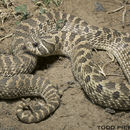en
names in breadcrumbs


The western hognose snake (Heterodon nasicus) is a species[2] of snake in the family Colubridae. The species is endemic to North America.
The specific name, nasicus, is from the Latin nasus ("nose"), in reference to the upturned snout.[3]
The subspecific name, gloydi, is in honor of American herpetologist Howard K. Gloyd (1902–1978).[4]
The subspecific (or specific) name, kennerlyi, is in honor of American naturalist Caleb Burwell Rowan Kennerly.[4]
Common names for Heterodon nasicus include blow snake, bluffer, faux viper, plains hognose snake, prairie hognose snake, spoonbill snake, spreadhead snake, Texas hognose snake, Texas rooter, and western hognose snake.
Some authors elevate H. n. kennerlyi, also known as the Mexican hognose snake, to species level. Those same authors have subsumed H. n. gloydi into H. nasicus so that there are only two species (H. nasicus and H. kennerlyi) and no subspecies.
The western hognose snake is a relatively small, stout-bodied snake. Its color and pattern is highly variable between subspecies, although most specimens appear much like rattlesnakes to the untrained eye, which appears to be Batesian mimicry. Males are considerably smaller than females, with adults rarely exceeding a total length (including tail) of 40–50 cm (15–20 inches). This snake gets its common name, "hognose", from the modified rostral (nose) scale that is formed in an upturned manner, providing a very "hog-like" look. Additionally, this adaptation makes these snakes adept burrowers.[5]
The species is not dangerous to humans, but there exists scientific debate regarding whether the mild toxins in the hognose's bite result from saliva, harmful to its preferred wild food source – toads – or an extremely mild venom produced in glands connecting to the hognose's minuscule rear fangs. In either case, no deaths or systemic effects from the extremely rare bite from this rear-fanged snake have been recorded.[6] Although bites may uncommonly be medically significant, the species is not regarded as venomous.[2]
In captivity, the species has been bred into about 52 different "designer" color morphs.[7]
The western hognose snake occurs from southern Canada throughout the United States to northern Mexico. It frequents areas with sandy or gravelly soils, including prairies, river floodplains, scrub and grasslands, semi-deserts, and some semiagricultural areas.[1] It has been found at elevations of up to 2,500 m (8,200 feet).[6]
The western hognose snake is primarily diurnal. It is typically a docile snake (though known to be highly defensive in some individuals). If threatened (or perceiving a threat), it may flatten its neck (much like a cobra), hiss, and make 'mock' or 'bluff' strikes if harassed, which are strikes made at an intruder but with the snakes' mouth closed. Subsequently, even when further harassed, western hognose snakes virtually never bite as a self defense mechanism, but will instead usually resort to playing dead.[8][9] Although it is more common that it will flatten its head, some individuals may puff up, filling the throat with air. This is more common with adolescent males.
In the wild, the western hognose snake feeds predominately on amphibians, such as large and medium-sized tree frogs, as well as small or medium-sized toads and small lizards. There have been accounts of H. nasicus eating the occasional rodent in the wild as well. Not being a true constrictor, Heterodon bites and chews, driving the rear fangs into the prey as a way of introducing the saliva to help break down the toxins from toads. There have been many cases of hognose snakes in captivity that will not eat for about two to three-and-a-half months, from the months January to mid March. This is because hognose snakes' instinct is to brumate underground during the winter months.
Adult western hognose snakes have been observed in copulation as early as February and March. The species is oviparous, with females laying 4–23 elongate, thin-shelled eggs in June–August. The eggs take approximately 60 days to hatch. Each hatchling is 13–23 cm (5–9 in) in total length, and reaches sexual maturity after approximately two years (this is predominantly based on size, not so much age).[10]
Although some local declines have been reported, the species H. nasicus is widespread, has a large overall population size (> 100,000), and is effectively protected by a variety of conservation programs. It is therefore currently classified as Least Concern by the IUCN. The eastern hognose snake (Heterodon platirhinos) is classified as a threatened species in some regions of its range and is therefore protected under those states' laws.[1]
The western hognose snake (Heterodon nasicus) is a species of snake in the family Colubridae. The species is endemic to North America.